Carbon footprint, Net Zero, ESG, and the European Green Deal are just a few terms that have recently been on the agenda of many European companies. Under the upcoming CSRD directive, starting in 2024, more and more companies will be required to disclose sustainability data. Similar trends are also noticeable outside Europe. According to PRI21 research, more than 730 modifications have been made to almost 500 legislative instruments worldwide only in recent years.
According to all predictions, information about the company’s actions in the field of sustainable development will become an increasingly important criterion, both in the case of making individual consumer choices and choosing a place of employment or business-to-business collaborations.
The article will answer the question of how to use Salesforce Net Zero Cloud to prepare an ESG factor report.
Is it only about the annual preparation of the report?
Adapting the organization to the new reality is undoubtedly a challenge and a significant investment for many companies. As we can infer from the new regulations, the sustainability report is to become a fully-fledged part of the companies’ annual report, as important as the financial report. However, it is important to emphasize that the annual creation of a sustainability report should not become an end in itself. By definition, the ESG strategy should be considered an integral part of a company’s strategy.
Furthermore, activities around climate neutrality should be treated as a process that is constantly evaluated and adjusted to minimize the organization’s impact on the environment as effectively as possible. With this approach, the report has mainly a managerial function – to indicate the direction of actions and, by tracking progress, to help in setting more and more ambitious goals. In other words, the report is a kind of signpost on the road to climate neutrality and a source of information that can then be translated into concrete actions within the organization, e.g., while planning business trips or proceeding with sales activities. In addition, the report has a communicational function – it introduces the organization’s sustainability-related actions to customers, partners, and institutions and presents the company as responsible, committed, and transparent.
How to get started
So, how to adapt to the new reality and get started on your quest for climate neutrality?
The stage of preparing the organization to report on non-financial factors is definitely a key stage. If we carry it out without much reflection, problems may arise at each subsequent step in the process of report creation. So, how do we get started?
The best start will be to select people who will be responsible for developing ESG-related activities in the organization. This step should be followed by mapping the company’s key business processes and materiality analysis – an assessment of the organization’s impact on the environment. After identifying the key ESG aspects for the organization, it is high time to select the appropriate indicators in accordance with the reporting standard or standards that you decide to use or which you will be obliged to use due to applicable regulations. This brings us to the stage of data collection and analysis.
At this step, it is worth using an IT tool that will structure the entire process, aggregate all ESG-related data in one place and provide a platform for forecasting, data analysis, and data operationalization in various business processes. The Salesforce Net Zero Cloud is undoubtedly such a system. What makes it unique?
Salesforce Net Zero Cloud – technological benefits
Net Zero Cloud was initially developed by Salesforce for in-house use. Over time, as the functionality developed, it was presented as a commercially available product.
What are the main benefits of choosing this particular tool?
- Access to advanced process automation tools, Einstein AI layer, multi-channel notifications, and approval processes. By being part of the Salesforce platform, Net Zero Cloud benefits from the functionalities that make Salesforce CRM the world’s #1 solution.
- A wide range of possibilities in terms of integration with external systems and data import to give us a full picture of our emissions in a single tool, which will become the ESG command center for your organization.
- Access to powerful reporting and data visualization modules. By linking with Tableau CRM, Net Zero Cloud allows users to create complex analyses and predictions. The ESG reporting templates prepared in the system will provide direction and significantly speed up the work of those responsible for managing ESG data in your organization.
- Automatic calculation of the level of greenhouse gas emissions for three ranges in accordance with the GHG Protocol based on data collected in the system and emission factors that are available in the system out of the box.
- The ability to set up a Supplier Portal, which enables the exchange of information between your organization and the companies you work with. Suppliers can enter their emission levels manually, by importing files or using various plug-ins or connectors. Aggregating data from suppliers allows you to report data across the whole supply chain, which is necessary if your supply chain activities are those that have a significant impact on the environment. A Supplier Portal can also play an educational role – it familiarizes your partners with the subject of ESG through articles and tutorials, showing them what exactly you expect from them and why.
- Thanks to the connection to the other Salesforce clouds, it is possible to use ESG-related data in decision-making at the level of differentiated business processes such as sales or logistics, e.g., when planning business trips.


Operationalization of ESG data
Referring to the last point mentioned – the consolidation of environmental data and data from other Salesforce applications – when using Sales Cloud, we can display specific parameters of a Product, such as its carbon footprint, durability, and reparability (resulting, for example, from the availability of spare parts) or recyclability. If the product parameters are unsatisfactory, the system can suggest an alternative product – a more environmentally friendly substitute.
In the screenshots below, we can see the specific use of ESG data in the sales process:

Also, while using Sales Cloud, we can motivate our internal sales department to sell more environmentally friendly products, as well as motivate customers to choose them. In the screenshot below, we can see that on the Opportunity view, its rating is available in terms of how environmentally friendly it is. Thanks to the prompts available in the system, the sales employee can see which particular Products within an Opportunity are ‘eco-friendly’ and which are not.
The aforementioned motivational aspect also comes into play – if a salesperson successfully proposes an eco-friendlier product to a customer, their sales commission may increase. Similarly, the system can prepare customer evaluations. If the customer chooses a product that is better for the environment, they may receive additional points in the rating, which can then translate into various benefits, such as an extended payment period for the order, free delivery, or a discount on the order.
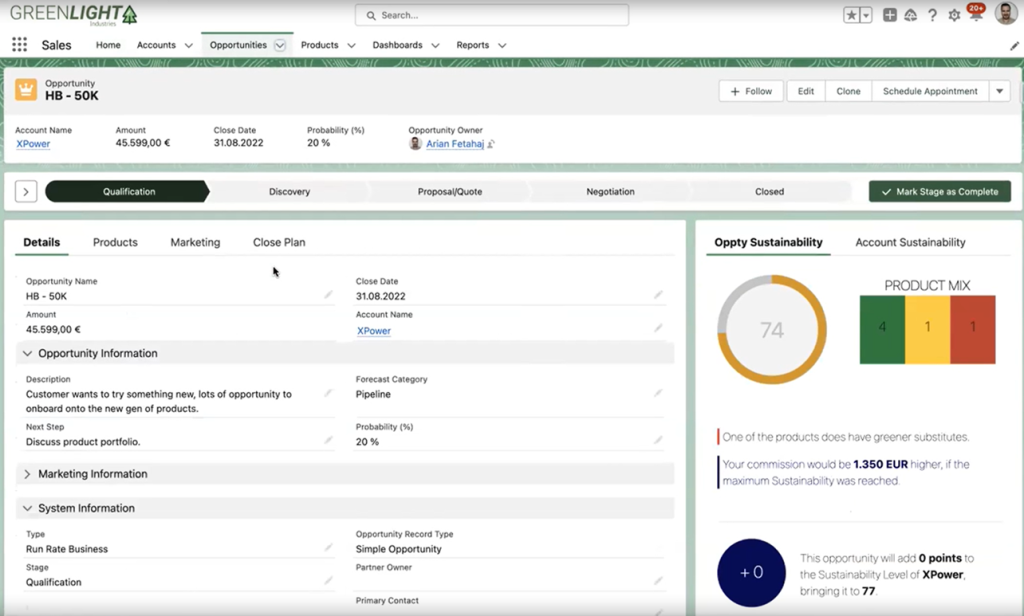
Data aggregation in one place – how does it work?
The mechanism for data presentation and transformation in Salesforce Net Zero Cloud is well illustrated on the diagram below:
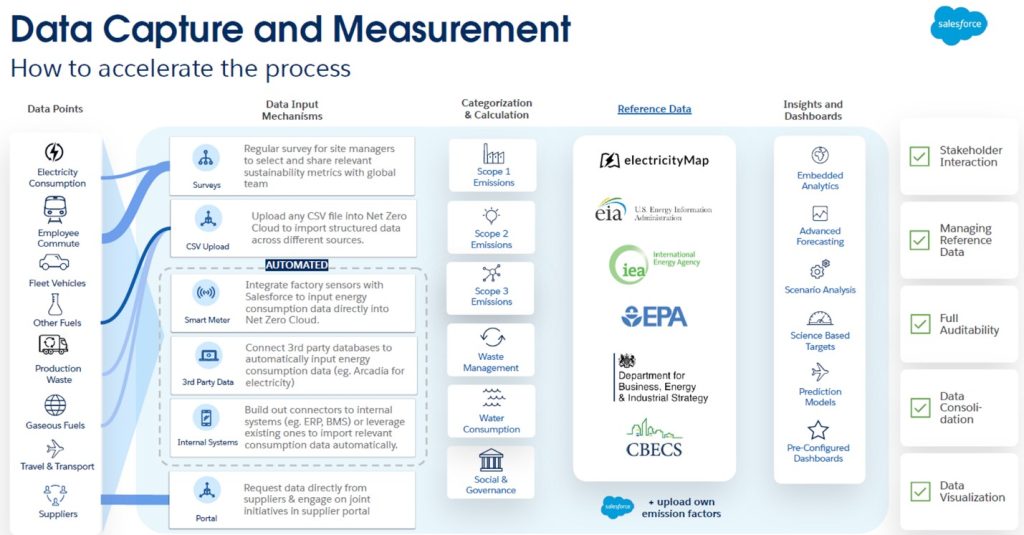
Calculation of the carbon footprint (Carbon Accounting)
A carbon footprint is an estimation of the total amount of greenhouse gas emissions to the environment caused directly or indirectly by a person, organization, event, or product. It is expressed in the amount of CO2 equivalent. The Salesforce Net Zero Cloud allows to calculate the level of greenhouse gas emissions for three ranges in accordance with the GHG Protocol:
- Scope 1 applies to direct emissions generated by resources owned or controlled by the organization, such as stationary assets or company mobile vehicles.
- Scope 2 describes indirect emissions, specifically emissions created by the consumption of energy that the organization has purchased from its suppliers, such as electricity consumption and heating or air conditioning at the organization’s stationary assets.
- Scope 3 represents other emissions resulting from the whole supply chain, business travel, waste management, the manufacture of raw materials or intermediates, and more.
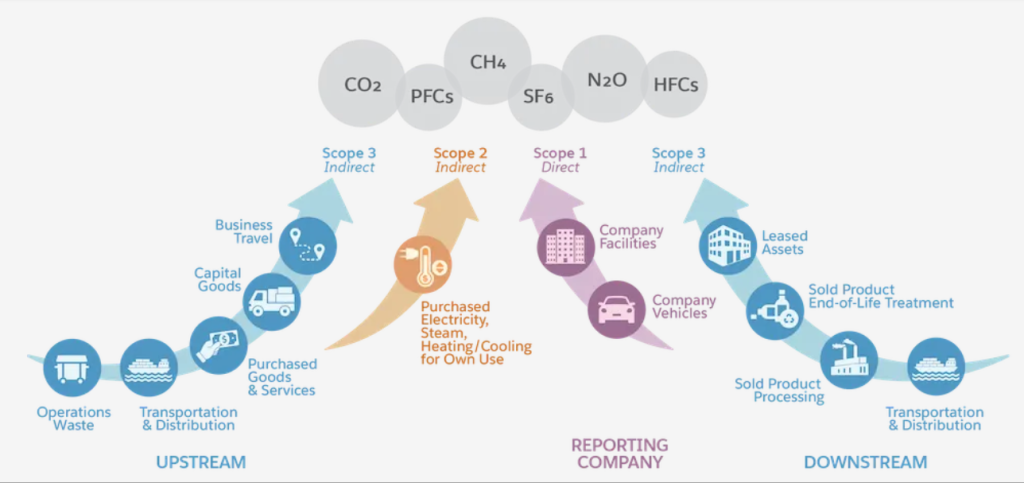
Within Net Zero Cloud, there is a division into three types of carbon footprint, each corresponding to different emission sources. The three types of carbon footprints are:
- Stationary Assets Carbon Footprint: this includes emissions generated by a company’s stationary assets, such as its headquarters in different cities, warehouses, production halls, or data centers.
- Vehicle Assets Carbon Footprint: this encompasses emissions produced by mobile assets, specifically vehicles owned by the organization.
- Scope 3 Carbon Footprint: it collects emissions relating to Scope 3, meaning the sources which have already been described above.
Emissions sources are reflected in Net Zero Cloud in analogously named objects: Stationary Asset Environmental Sources, Vehicle Asset Emissions Sources, and Scope 3 Emissions Sources.
Energy Use Records
Another element in the data model used to calculate the carbon footprint is the Energy Use Records object. Records are created to describe the consumption for a specific date or date range per emission source. For example, these records may capture electricity consumption for a stationary resource in a given month (i.e., the consumption resulting from the bill we receive from the utility provider) or a single flight for an overseas business trip.
Emissions Factors
The last elements are Emissions Factors, which are used to convert energy consumption into greenhouse gas emissions. Salesforce provides many sets of Emission Factors that are available out of the box. Additionally, this database is regularly expanded as part of the releases that Salesforce carries out three times a year (Winter, Spring, and Summer releases). In cases where the desired Emission Factors are not available in the system, you have the option to add your own.
This allows you to incorporate Emission Factors that are required by government institutions in your country or region, or issued by private entities and specific to your industry.
By aggregating all the necessary data in Salesforce and using the emission factors, we obtain automatically calculated tCO2 emissions.
To conclude: Consumption x Emission factors = Emissions expressed in tCO2e (tone of carbon dioxide equivalent)
Thanks to Salesforce’s standard functionality, specifically the ability to visualize the records gathered in the object in a Kanban view, we can easily observe the stage we are at in terms of calculating the carbon footprint for each stationary or mobile asset.
Whether this will be a stage of data collection, filling gaps (e.g., in collaboration with suppliers), data validation, renewable energy allocation (either through the standard method or by utilizing Net Zero Marketplace, which enables the purchase of Carbon Credits – certificates representing carbon dioxide neutralization by supporting NGOs. For now, this feature is only available in the United States), or an audit stage (both internal and external). The final goal is to ensure the completeness and readiness of the aggregated data within a specific record for inclusion in the ESG report.
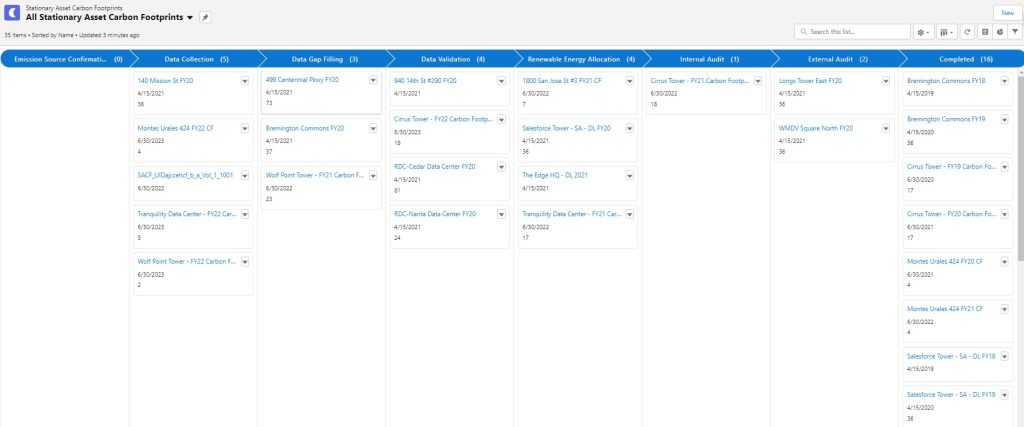
What-If Analysis
By using What-If Analysis module, we can simulate and visualize the potential impact of ESG-related actions on actual emissions. By examining different scenarios, we are able to observe which actions will be most effective and which will ultimately bring us closer to climate neutrality. This is an excellent tool to support long-term planning.
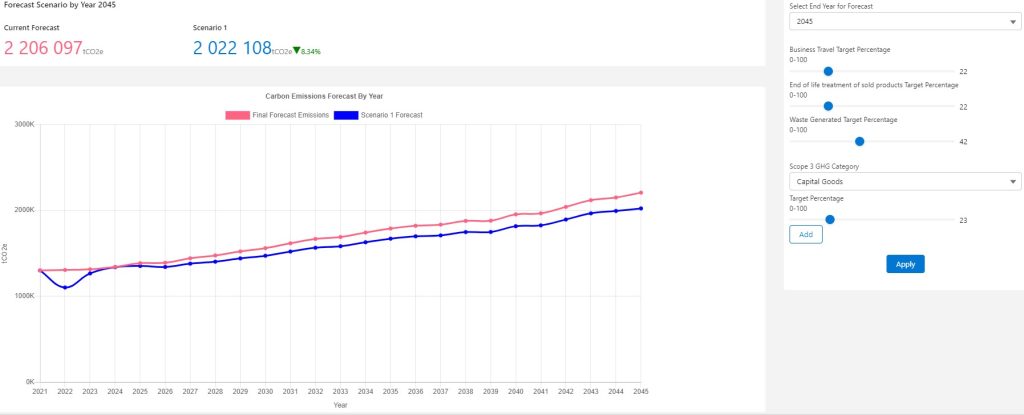
Science-Based Targets
The Target-setting module in aligned with Science-Based Targets. When mentioning targets, it is impossible not to mention the Science-Based Targets initiative, which shows organizations a clearly defined pathway for reducing greenhouse gas emissions in line with the 2015 Paris Agreement goals of keeping global warming below 1.5 degrees Celsius. Joining the initiative holds significant educational value for companies and positively impacts their reputation and perception by various institutions and consumers.
Salesforce Net Zero Cloud includes a module that structures and simplifies the Science-Based Targets application process. By using Approval Processes, we are assured that all people in the organization who should be involved in the matter of ESG will agree to a specific commitment. For more information on the Science-Based Targets initiative, visit this page.
Water Management
Functionality to track key indicators regarding water-related activities, i.e., water consumption, withdrawal, and discharge. These activities should be recorded as records in the Stationary Asset Water Activity object and linked to the source through the Stationary Asset Environmental Sources object, which was already described in the Carbon Accounting process above.
To consolidate the water-related data and calculate water footprint, the Stationary Asset Water Activity records for a specific source are aggregated for a given period, typically one year. The consolidated annual summary (Stationary Asset Water Footprint) provides information such as total water consumption, resulting expenses, and the intensity of consumption calculated using various criteria, such as water consumption per: number of employees, size of the stationary resource (i.e., office size), or production scale (i.e., the volume of products produced).
Based on the location of the stationary asset, we can enter information on the water risks for this region. Risks can be supplemented with, for example, the Aqueduct Water Risk Atlas tool, which indicates where water-related risks and opportunities are occurring around the world. Aggregated information on water use in different years, for different sources, within different activity types is provided by the Water Management dashboard.
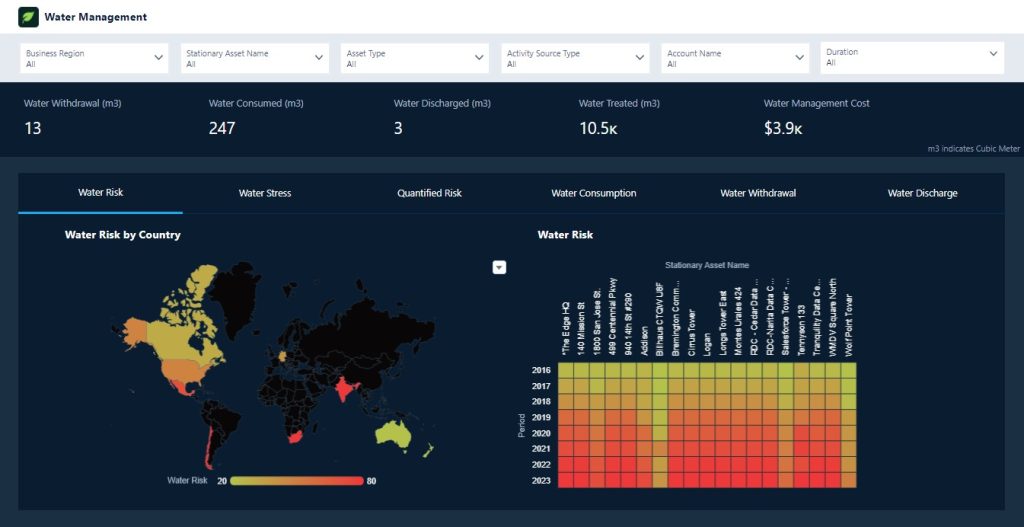
Net Zero Cloud Data Model
The data model consists of a set of objects and the relationships between them. These objects have been aggregated to form the Net Zero Cloud application. Access to the application, the objects within it, and the Net Zero Cloud-related data can be granted to users through Profiles and Permission Sets. Salesforce recommends the use of two profiles:
- Net Zero Cloud Manager – for users with the ability to add new records, edit existing data in the system, and create and modify dashboards.
- Net Zero Cloud Auditor – for users who should not have access to edit data. These users should be able to analyze reports and dashboards and initiate interactions to other team members, for example, via Chatter. This profile should be assigned to people who will perform tasks as the internal auditor – the person responsible for verifying the data collected in the system before it is finally included in the company’s non-financial report and submitted for external audit.

Summary
The year 2023 marks the final call for large enterprises to prioritize non-financial reporting and align their ESG strategy with their overall business strategy. It is also an opportune moment for small and medium enterprises to focus on this matter. What’s more, we can predict that the requirement for non-financial reporting will spread over time, until it finally reaches every organization present on the European market.
Sustainability reporting is a complex task that demands considerable knowledge, either from internal company resources or through the expertise external consultants. Preparing an organization for reporting involves conducting a materiality analysis of its impact on the environment, selecting appropriate indicators and reporting standards, identifying data sources and analyzing the collected data. This is a time-consuming process that requires the involvement of many parties – stakeholders, management, many departments within the company, and often also suppliers.
Choosing the right tool can effectively structure this process and streamline many of its elements. Consequently, implementing the ESG strategy becomes more manageable and actions aimed at its execution seamlessly integrate into the overall business operations.
***
If you are interested in the subject of Salesforce, be sure to check out other articles by our experts.







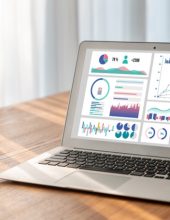




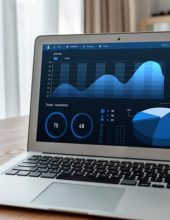



Leave a comment